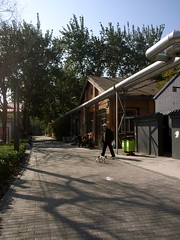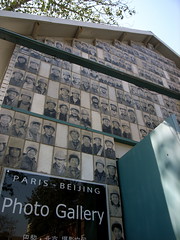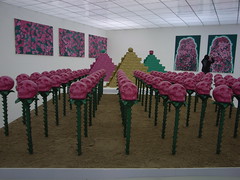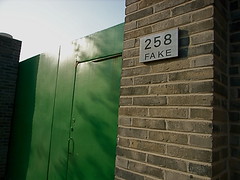

A one-day crash tour of the Beijing contemporary art industry could bring you to the following places:
(1) The Art Mall
The Dashanzi or 798 Art District is a district of old dis-used factory complexes and low warehouses/shops inhabited by artist studios and galleries since the 90s, but more distinctly marketed as an art destination in the last few years.
Today, it receives busloads of domestic and international tourists daily, and is the first destination mentioned not only by art magazines but newspaper travel reviews. There are cafes, souvenir stores, bins for recyclable waste, litter-free paved streets, new brand-name galleries from Korea (T-Space), New York (Pace Wildenstein), Italy (Continua)...and a new section supposedly developed with state support and ironically bearing the name "798 Originality Square".

Feng Zheng Jie's new work - glamming up death, decay and consumption.
With all the market hype about Chinese contemporary art, it is easy to decry the rapid developments at Dashanzi and the by-now familiar iconographic paintings of Mao, bald men, grinning or green faces as a kind of "in-authentic", factory (pun intended) art. But art and commerce have always served each other, first through patronage, then through industry. Sometimes the exchange gets too exclusive in its intimacy, and art's other relationships with critical process, society, invention etc appear distant or even absent - but hey, this is not unique to Chinese contemporary art. Perhaps the underlying discomfort is a post-colonial one, that the power in this exchange lies not in China but in "the west", the old boys of the art market.
(2) The Art Bungalow

the dusty neighbour, in the process of Beijing-style "upgrading"
As with all things Chinese, though not unique to China, these contradictions and tensions somehow grow to exaggerated proportions in the Middle Kingdom (not unlike the gigantic faux Parisian hotel across the street from the hotel I am staying in!)
After spending the first half of the day walking around the Dashanzi district, we walked and drove around the Cao Chang Di Art District (Detailed NYT Review here). Cao Chang Di is certainly more subtle than Dashanzi, but the contradictions remain. The Cao Chang Di galleries are mostly foreign-owned or off-shoots of foreign big name galleries. Located in a quiet district of warehouses and new, cube-like brick buildings that are barely visible behind high concrete walls, the mood in the tree-lined district is almost genteel. At the same time, the district sits right beside a still-dusty (very), unpaved warren of homes and little shops.
This maybe sums it up: at the Cao Chang Di, we walked pass what is supposedly Ai WeiWei's sometime studio, cheekily or perhaps very aptly labelled "258 FA KE". A self-parody and a raised middle-finger.

(3) The Art Factory

Xu Zhong Min's work at his studio
If you are lucky, you may get the chance to visit an artist studio.
We were brought to Xu Zhong Min's studio. Located an hour's drive away from the city, you will see, enroute, entire Truman-ville estates of "Little America" bungalows (with SUVs in the drive way and a 3 storey clubhouse) or modern Chinese mansions complete with fancy roofs and circular doorways.
Looking more like some village workshop housing some kind of contraband goods, his studio is in a large gated compound with a L-shaped workshop and an outdoor shed. When we got there, 4 of his assistants were cleaning some fibreglass skeletal figures that would later go on one of his stop-motion rotating sculptures. He tells us he had been to Singapore many times ("if there's a good party"), that a Singaporean collector had just bought another of his works a week ago, and that he works 6 days a week. Then he shows us his personal studio at the back. It is an airy, double-volume 200sqm space.
Trained as a print-maker in a Szechuan art academy before spending some years in the UK, his early print works and more recent oil paintings and prints line the walls. There is an impressive technical finesse and range in his work.

At the end of the visit, I am reminded that for all the cynicism (and perhaps jealousy?) that may now characterise attitudes towards the commercial success of these contemporary Chinese artists, these artists are very skilled and good at what they do, smart, talented, imaginative and inventive. Not forgetting that they work incredibly hard (single-handedly managing their assistants, collectors/gallery owners, production needs and finances), and have been doggedly pursuing their art for years, with or without commercial success.
Talent. Hard work. Persistence. If you don't have all 3 in abundance, I guess neither the art nor the capital will happen.
Comments